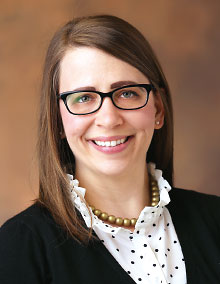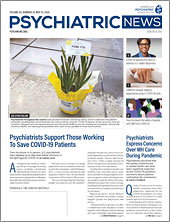As U.S. hospitals continue to be inundated with COVID-19 patients, much media attention has been given to shortages of critical resources such as ventilators and isolation facilities. Less well publicized is another complication resulting from this surge of patients requiring emergency or intensive care: increasing numbers of patients with delirium.
Delirium is an acute state of confusion characterized by delusions, poor awareness, restlessness, and/or agitation, among other symptoms. If left unattended, it can lead to severe outcomes such as bodily injury, cognitive impairment, and death. Delirium is triggered by biological stress that affects the brain. Reduced oxygen to the brain caused by lung damage, for instance, can interfere with brain function, resulting in delirium.
This novel coronavirus also has characteristics that make delirium even more likely, noted Jo Ellen Wilson, M.D., M.P.H., a consultation-liaison psychiatrist and assistant professor at Vanderbilt University Medical Center. One trait is the virus’s predilection to lead to more severe infections in older adults and adults with existing medical problems, both of whom are already at higher risk of delirium. Wilson told Psychiatric News there is some evidence that the coronavirus, like SARS and MERS viruses before it, may be able to invade the central nervous system and directly damage the brain.
The social isolation of patients may also increase their risk of delirium, Wilson noted. “You can imagine someone waking in a hospital room alone, sick and confused, and the only people they see are completely covered in protective equipment,” Wilson said. Such experiences can be extremely disconcerting to sick patients already in a semi-confused state and may exacerbate their condition, she said.
“[During this pandemic,] we will see a spike in delirium incidents, especially among older, vulnerable patients,” said Kevin Biese, M.D., co-director of geriatric emergency medicine at the University of North Carolina School of Medicine. “But with overall hospital volume also increased, it’s more likely that busy staff will forget about screening for delirium.”
Screening patients with validated assessments is important, noted Ula Hwang, M.D., a professor of emergency medicine and geriatrics at the Icahn School of Medicine at Mount Sinai, since delirium can be hard to detect in the majority of patients. According to Hwang, only 25% of patients with delirium appear visibly agitated.
“Everyone in the [emergency department] rushes to give medication to the clearly agitated patients, but the quiet and sleepy patients whose delirium is growing worse are left unattended,” she said. “But if we can plan ahead and take a few simple steps, we can identify at-risk patients and prevent a lot of bad outcomes.”
In addition to robust screening, Hwang recommended that health care workers ensure patients with breathing problems are receiving oxygen therapy and receiving acetaminophen for fevers and pain; this could prevent many cases of delirium before they happen, she said.
Delirium Screening Is Critical
Nidhi Rohatgi, M.D., a clinical associate professor of medicine at the Stanford University School of Medicine, agrees that comprehensive patient screening for delirium is critical. As part of an initiative on optimizing delirium care that she helped spearhead at Stanford, nurses in the medical and surgical wards screen all patients for delirium using a scale known as the Confusion Assessment Method (CAM). The scale assesses attention, disorganized thinking, acute onset, and more.
The nurses also screen all patients for delirium risk. “Preventing delirium is everyone’s responsibility, not just the psychiatrist’s, because once medications [that increase risk of delirium] have been administered or delirium has lingered on for some time, it is a much tougher job for the psychiatrist to reverse or resolve delirium, and it is more likely the patient may be left with long-term cognitive impairment,” Rohatgi said.
“One of the issues with predicting delirium is that the risk factors are different for the various patient subgroups across our hospital,” she said. By working with physicians across specialties, Rohatgi’s team came up with a short list of 10 common risk factors, such as older age or hearing/vision problems, that was broadly applicable if not perfectly accurate. Both the CAM screening and screening for patients at risk of delirium can be completed by nurses in two to five minutes, which is useful as staff may not have the luxury to conduct thorough risk assessments during a patient surge.
Regardless of the screening tool used, establishing a written plan for screening and treating patients with delirium is key to patient care, so all members of a health care team are on the same page. “This is not something you should be doing on the fly,” said Biese, who along with Hwang helped write up a brief tip sheet highlighting key principles of delirium care during the COVID era (see box on page 12). Though intended primarily for geriatric patients, many of these tips are applicable for all ages.
Delirium Care Complicated By COVID-19
Most delirium protocols involve identifying delirium, identifying the cause of delirium (for example, infection or low oxygen), and then treating the underlying cause of delirium as well as delirium symptoms.
Treating delirium in COVID-19 patients is a complicated matter. Studies have shown that the most effective measure to prevent or treat delirium is a tool known as the ABCDEF or A2F bundle. This tool encourages health care providers to work with patients to orient them to their surroundings, encourage movement, and engage with family and/or friends. For isolated COVID-19 patients recovering in crowded hospitals, implementing A2F care may be difficult. Also, a lot of skilled nursing facilities are not able to accept patients with COVID-19, so these patients must stay in the hospital environment much longer.
Difficult but not impossible, Wilson and others stress. “ABCDEF was designed to be flexible,” Wilson said. If a center doesn’t have available physical therapists to mobilize patients, for example, patients can at least be repositioned periodically. Other simple preventive measures include keeping blinds open during the day and ensuring patients are not retaining urine or constipated. “Staff should try to do what they can and get creative when needed.”
Sikandar Khan, D.O., M.S., a research scientist at the Indiana University Center for Aging Research at the Regenstrief Institute, has turned to music as one potential creative solution for delirium. He recently led a pilot study that showed that a few hours of slow, rhythmic music each day might reduce delirium severity in ICU patients on ventilators. What’s more, patients found the slow-tempo music as enjoyable as playlists suggested by family. “This is beneficial since it doesn’t put extra burden on bedside staff. … [J]ust place the headphones on patients and press play,” he said.
Khan, who has started another pilot study using virtual reality headsets to help ICU patients get exercise in bed, thinks technology can offer a low-cost/low-risk delirium interventions during this ongoing pandemic.
Biese agreed. “I can see a future where it’s standard practice to put an iPad in every hospital room,” he said. “It’s an easy way to ensure isolated patients are always close to social support.”
Rohatgi also emphasized the importance of empathy when working with patients who may be experiencing delirium. “[W]hen you do an in-person evaluation, just take two minutes to ask the patient some questions not related to the diagnosis, like what they like to do in their spare time or how they are really feeling.” Just because physicians have a covered face does not mean they cannot exude empathy.
“Health care workers are rightfully afraid of exposing themselves and their families [to COVID-19],” Wilson said. “But despite our fears, we have to slow down and remember to practice evidence-based medicine. The guidelines we had in place a few months ago are still the best approach today. It’s important that we continue to provide rigorous, patient-centered care even in these taxing times.”
She cautioned that if health care professionals “go soft” and default to using antipsychotics or benzodiazepines for agitation in patients instead of taking time to assess patients for delirium, it could lead to “an avalanche of delirium cases today and new-onset dementia cases tomorrow.”
Hwang predicted that COVID-19 is likely to lead to lasting changes in emergency medicine. She said she hopes one of these changes might be a better system of emergency care, which treats delirium as a priority. “I’ve had many colleagues from other specialties ask how they can help us. I think raising awareness about delirium and how to spot it is something psychiatrists can do during this current epidemic.” ■
More information on Rohatgi’s delirium program is posted
here.
More information on Khan’s music therapy trial is posted
here.


